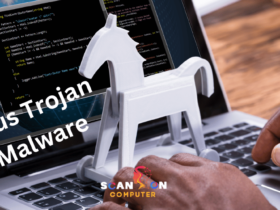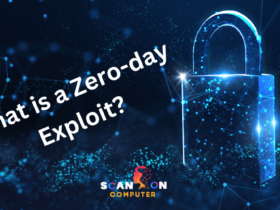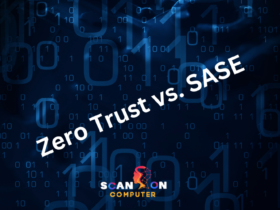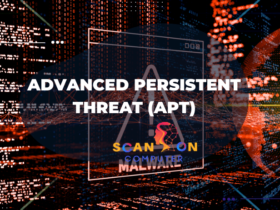Next-Generation Antivirus (NGAV) uses machine learning algorithms, cloud scanning and a lightweight agent to minimize impact on endpoint performance, so security teams can keep an eye on their environments without worrying about performance issues.
Computer viruses were once dangerous threats, corrupting data, crashing systems and slowing operational capacity. Traditional antivirus software protected users by matching malicious code with known signatures to detect threats.
Modern cyberattacks are far more sophisticated, using multiple techniques and tactics to bypass legacy antivirus solutions. Businesses should update their antivirus protection with a proactive solution rather than reacting when an attack happens.
What is next-generation antivirus NGAV?
Traditional antivirus software largely relies on an extensive signature database for known threats; while this method may provide adequate protection against viruses, it doesn’t protect businesses against rapidly evolving attacks that target businesses directly.
NGAV was designed to fill this void. Utilizing cutting-edge technology, NGAV monitors all behavior across your endpoints in search of signs of possible attacks – even those that don’t fit the traditional mold of malware or signature-based EDR solutions. NGAV stands out by its proactive monitoring ability.
NGAV is typically cloud-based, making its deployment and implementation quick and painless without requiring major hardware investments or upsetting your security environment. NGAV utilizes several technologies-including machine learning, behavioral detection, adware/exploit blocking and attack attribution-to detect both malware-less attacks and their perpetrators. Furthermore, extended detection and response (XDR) features offer greater protection by correlating alerts from various telemetry sources to identify actionable threat intelligence that helps anticipate attacks before they cause damage to your business.
How does NGAV work?
Attackers have learned how to circumvent traditional antivirus solutions, so more intelligent detection focused on prevention is required. NGAV uses advanced heuristics and behavior analysis engines to quickly recognize threats and block them before they cause serious disruption across crucial endpoints and the enterprise.
NGAV examines your files, processes, network connections and more to assess what’s normal and abnormal before performing advanced analysis on systems and behaviors to identify cyberthreats using predictive analytics and machine learning (ML).
NGAV also blocks attacks such as ransomware, which seeks to encrypt your data before demanding money for decryption. Unlike legacy antivirus products, NGAV detects and prevents such threats before they cause financial and reputational harm; additionally, its cloud architecture and lightweight agent minimize the impact on endpoint devices.
Next-generation antivirus vs EDR
NGAV solutions are intended to surpass traditional antivirus software by employing cutting-edge technologies such as machine learning and behavioral analysis. Most are cloud-based solutions, offering agility, speed, scalability and affordability benefits.
Cyber attacks have evolved exponentially over time, and traditional antivirus programs cannot keep pace. Malware designed for today’s cyber threats seeks to steal data, corrupt systems, extort money and disrupt business operations – thus necessitating more robust tools to defend against this new breed of threats.
That’s where next-generation antivirus (NGAV) and EDR (endpoint detection and response) solutions come into play, helping detect, investigate, and respond to threats on endpoints – ultimately helping to safeguard sensitive information and keep business operations uninterrupted. Together, these tools help detect, investigate, and respond quickly to threats on endpoints; ultimately helping prevent the loss of sensitive data or disruption to daily business. NGAV/EDR combined can stop advanced threats before they cause irreparable damage; so the next step towards increasing IT security could be adopting an EDR service offering managed detection / response capabilities like Cybriant’s Managed Detection & Response (EDR).
1. Known attack detection
Traditional antivirus software compares files against signature libraries to detect threats, but hackers have found ways to bypass this approach. With NGAV’s comprehensive approach that includes machine learning, evasion blocking, exploit blocking and threat attribution for every file it examines NGAV helps prevent attacks by inspecting all its attributes – machine learning, evasion blocking exploit blocking threat attribution etc are just a few methods utilized against attackers.
NGAV (network endpoint detection and response software) takes preventative measures against cyberattacks; unlike EDR software which only reacts after they have occurred. Furthermore, it requires less resources and has faster implementation times compared with legacy antivirus solutions.
A reliable NGAV solution should be able to operate without needing cloud connectivity in order to protect offline devices, be easily integrated with existing infrastructure, and require minimal IT resources for management. In addition, it should detect and stop advanced malware threats, such as ransomware, fileless attacks, or new security scenarios; by doing this it becomes an invaluable way of protecting small businesses against cyberattacks while EDR relies on IT teams detecting attacks after they occur.
2. Behavioral analysis
Behavioral analysis is an advanced form of malware detection. It uses machine learning to look for suspicious behaviors, identifying threats that are unknown or have not been classified. This prevents them from being executed on the endpoint before they can cause harm and enables a proactive defense against ransomware and other malicious software.
Traditional antivirus solutions use signatures (unique hashes linked to known malware files) to identify and prevent attacks. However, sophisticated attackers have discovered ways to bypass this system by exploiting fileless attacks and other tactics that do not introduce new files into a network.
Next-gen AV prevents these types of attacks by using innovative prevention tools and approaches. These include machine learning, heuristic analysis, memory scanning, exploit blocking, attack attribution, custom whitelisting and blacklisting, adware blocking, and more. These technologies also eliminate the need for a signature database that requires regular updates. NGAV’s cloud architecture and lightweight agent minimize the impact on endpoint devices, ensuring security without sacrificing performance. This is a fundamentally different approach from legacy antivirus, which can be slow to detect and block threats, requiring more time for update deployment.
3. Exploit mitigation
At one time, computer viruses were destructive threats that threatened data integrity, crashed computers, and impaired operational capacity. With improved signature detection technology and databases from cybersecurity companies, however, these threats became less destructive; but malicious attackers have since created more advanced malware that bypasses legacy security products to steal information, generate revenue streams, or cause tracking, identity theft, extortion, or business disruption.
NGAV includes advanced security tools like exploit mitigation to protect against cyberattacks. If an evasive attack is detected, exploit mitigation can block it without impacting legitimate files and applications – providing a vital way of stopping malware attacks from spreading throughout an organization.
Traditional antivirus requires frequent signature updates and scans that can reduce endpoint performance, but next-generation antivirus uses cloud architecture to deploy and monitor endpoint activity in real time, using artificial intelligence, machine learning and behavioral analysis techniques to identify threats. This comprehensive approach called extended detection response (XDR) protects both known and unknown threats.
4. Machine learning
Since cybercriminals are constantly devising innovative techniques and strategies to avoid traditional antivirus software, CISOs understand that traditional set-it-and-forget-it approaches no longer suffice in protecting businesses against advanced threats. Modern businesses require an innovative cybersecurity solution which can detect and prevent these advanced threats without disrupting everyday operations or performance.
NGAV delivers this protection through multiple sophisticated prevention methods, such as machine learning and behavioral detection technologies. These approaches go beyond signature-based malware identification by taking into account all aspects of files’ characteristics and behavior on an endpoint; this enables a more effective attack prevention strategy against unknown attacks such as ransomware and fileless malware.
NGAV’s cloud-based management and rapid deployment make implementation quick and straightforward; unlike legacy antivirus solutions that may take weeks or even months to roll out across an organization. Now small and midsized businesses can gain enterprise-grade protection that’s simple to deploy, manage, use on one console – not to mention supporting multiple device types and operating systems! To find the ideal NGAV solution for you contact us now.
5. Automation
Modern cyberattacks are too sophisticated for traditional antivirus solutions to effectively address. To provide complete prevention against these cyberthreats, NGAV utilizes cutting-edge technologies like artificial intelligence, machine learning, behavioral analysis, exploit mitigation and cloud capabilities in order to stop both known and previously unseen attacks.
NGAV differs from traditional antivirus software in that instead of using signature databases to identify malware, its detection engine uses artificial intelligence-powered heuristic detection techniques that look for characteristics associated with specific threats – this approach is much more accurate than matching files against signature lists which can easily be mislead by similar constructions.
This technology is also flexible, as it doesn’t need regular updates that bloat agents and slow down endpoints, making NGAV fast and non-disruptive while protecting the most essential assets within an organization. Furthermore, the best next-gen security companies often combine NGAV with EDR to protect against advanced and unknown attacks – this approach is known as extended detection response (XDR), and works alongside NGAV to identify potentially risky activities on your network quickly so you can respond before significant loss occurs.
Contrary to traditional antivirus solutions that rely on signatures to detect suspicious activities, NGAV employs more advanced forms of technology for increased protection from various attacks; including fileless malware that bypass legacy AV software.
6. Cloud-based management
NGAV goes beyond traditional antivirus software in that it utilizes extended detection and response (XDR) capabilities for proactive cybersecurity measures. By correlating alerts from various telemetry sources, this system can identify attacks based on prior behavior patterns as well as foil any attempts at avoidance using AI or machine learning technologies.
As such, NGAV provides effective protection from modern threats that traditional antivirus solutions cannot identify or stop, such as fileless malware and other advanced attacks. And its lightweight architecture means less performance impact for endpoint devices.
NGAV uses machine learning and cloud architectures to make managing updates and scans simpler for security teams, leading to lower total cost of ownership than legacy antivirus solutions. Deployment times for many NGAV systems can be achieved within hours; plus as it doesn’t rely on signatures, upgrading definitions becomes unnecessary; its primary goal being preventing cyberattacks by monitoring files, processes and even hacker tactics techniques and procedures (TTPs).
7. Remediation
Modern cybersecurity solutions must not only detect and eliminate known threats, but must also remove the mechanisms that enable malware to return. A modern Next-Gen AntiVirus platform offers automated remediation technology which works to remove artifacts or mechanisms which might facilitate its return. Unlike traditional antivirus programs that simply sit there until updated by themselves periodically, NGAV solutions typically use cloud technology that offers continuous updates in response to rapidly developing attacks.
NGAV uses machine learning, behavioral analysis and artificial intelligence to detect threats that would otherwise go undetected. Furthermore, memory analysis monitors processes to alert if they perform an illegal action. NGAV allows you to respond faster to potential threats, and stop them before they attack endpoints. Furthermore, due to being cloud-based software it can be deployed and updated much more rapidly than traditional antivirus products. Combining all these features together makes NGAV much more effective at protecting businesses against today’s cyberattacks, thanks to its superior detection capabilities. Because of this, many businesses also employ other security tools like EDR or XDR (extended detection response) for maximum effectivity.
Why is traditional antivirus outdated?
Once upon a time, viruses were a serious threat to cybersecurity, corrupting data and degrading computers’ operational capacities. With improved signature detection technology and updated databases from cybersecurity companies, viruses became less of an issue – however malware creators increasingly turned their focus toward more complex attacks that traditional antivirus software struggled to identify such as ransomware, phishing scams and cryptojacking attacks that traditional antivirus couldn’t stop.
Legacy antivirus systems attempt to mitigate cyberthreats using string patterns (signatures) that correspond with information stored in their database; this approach no longer suffices in combatting modern security threats.
Next-generation computer antivirus solutions utilize behavioral analysis, machine learning, AI, live monitoring and intention monitoring technologies to detect and stop cyberattacks before they cause damage. Plus they’re cloud-based so they’re easy to deploy and manage for small to midsized businesses while providing scalable protection that won’t bog down endpoints. And don’t worry about updating antivirus software regularly either – your NGAV solution takes care of that automatically!
Difference between NGAV and XDR
NGAV stands apart from traditional antivirus by employing advanced prevention methods beyond simply scanning files for malicious code. Leveraging machine learning and behavioral detection techniques, NGAV can detect fileless malware attacks much earlier in their kill chain than traditional solutions do.
A good NGAV solution utilizes machine learning to detect attacks by analyzing events, processes, and connections; taking into account how hackers utilize tactics, techniques, and procedures (TTPs) for risk identification; as a result of which it can block zero-day ransomware attacks and fileless threats which traditional antivirus solutions don’t detect.
NGAV can protect networks by identifying anomalous behavior and patterns associated with known bad actors, as well as integrate with existing SIEMs to reduce dwell time and enable security teams to respond faster and minimize damage. Partnering NGAV with EDR software like XDR ensures the entire network ecosystem is safeguarded from cyberattacks; it detects and mitigates attacks bypassing NGAV as well as any that bypass security perimeters.
Benefits of next-generation antivirus
Traditional antivirus software relies on signature-based detection to safeguard endpoints against malware, comparing files with a database of known viruses to detect and block any infected ones. But today’s threat landscape has changed substantially since legacy antivirus programs first came onto the scene.
Modern cyberattacks are designed to bypass anti-virus protections. Attackers look for vulnerabilities in operating systems, applications and networks and exploit mitigation techniques like memory scans, macros or shell commands in order to gain entry.
NGAV employs an arsenal of cutting-edge technologies to combat both known and unknown threats, such as artificial intelligence driven by machine learning, behavioral analysis, cloud architecture and exploit mitigation. Furthermore, its system monitors endpoint activities and notifies human cybersecurity experts of any suspicious activities – enabling NGAV to respond swiftly and prevent attacks before they start; providing better protection without impacting performance or taking up time on installation days instead. Compared with traditional antivirus solutions such as McAfee or Avast!, implementation for NGAV can take only minutes instead of days!
1. Reduce Operational Costs
As cybersecurity threats become more sophisticated, IT teams must deploy more security tools in order to keep pace. Unfortunately, this often results in multiple agents running simultaneously on each endpoint, leading to performance impacts and management complexity.
Next-gen antivirus (NGAV) solutions offer multilayered endpoint protection to reduce the number of agents running on each endpoint and enhance performance. Utilizing cloud capabilities, machine learning algorithms and behavioral analysis techniques, next-gen anti-virus protection helps detect unknown threats while stopping cyberattacks that bypass traditional anti-virus protections.
Contrary to traditional antivirus software, which uses signature-based detection for file scanning, NGAV employs machine learning and behavioral analysis techniques to detect new and unknown threats – giving IT professionals a proactive approach to cybersecurity protections that go beyond those offered by traditional anti-virus solutions. This also protects against new attack vectors that bypass anti-virus protections altogether.
NGAV can also detect malicious behavior such as ransomware and prevent its execution, helping businesses reduce downtime and data loss while saving time and resources through reduced disruptions and manual remediation efforts. Furthermore, it can protect against threats like operating system credential dumping which allows malicious actors to steal credentials to gain entry to systems.
2. Save Time
NGAV solutions employ artificial intelligence, machine learning algorithms, and behavioral detection to anticipate and prevent unknown threats – eliminating false positives from legacy antivirus software that would otherwise plague you.
Traditional antivirus solutions are reactive, meaning that they only activate when they detect an attack on your endpoints. As a result, their scanning and updating processes can slow down performance significantly; while next-generation antivirus is proactive and does not slow down endpoint performance during threat scanning or updates.
NGAV solutions not only detect attacks as they happen, but they can also block attackers by recognizing script technologies they employ – making it easier to stop ransomware attacks and other forms of fileless malware. Furthermore, these solutions prevent attacks by blocking communications with devices in your network from hackers looking to gain entry and steal data or launch attacks against your infrastructure – providing crucial protection from data breaches or revenue losses for businesses.
3. Improve Protection
Next-gen antivirus programs differ significantly from legacy antivirus software in that they use modern technologies like machine learning and cloud architecture to detect and block threats before they strike, without needing user input to do so. Heuristic analysis detects suspicious code by its structure or behavior to stop threats before they strike; this protects sensitive data, hijack devices or launch ransomware attacks without user interaction or intervention from being stolen by criminals.
NGAV’s built-in AI learning enables it to anticipate and prevent threats that have not yet been seen before, using a system-centric approach which analyzes processes, files, network connections and activities on endpoints to determine whether an activity is normal or suspicious. Furthermore, behavioral detection, artificial intelligence algorithms, machine learning capabilities and exploit mitigation help anticipate cyberattacks before they happen – plus deployment only takes hours unlike months with traditional antivirus solutions! Plus it constantly updates in the background for maximum protection in an ever-evolving threat landscape!
Each year, cyberattacks become more sophisticated and severe; to stay secure against them, your cybersecurity tools must also evolve – that’s where next-generation antivirus (NGAV) comes in handy.
NGAV leverages advanced preventive capabilities to stay one step ahead of threats, such as machine learning, behavioral detection, exploit mitigation and cloud architecture to combat both legacy attacks as well as non-signature based ones that may bypass traditional signature detection technology.
4. Boost ROI
Contrary to legacy antivirus that uses signature-based detection, NGAV uses machine learning algorithms and cloud architecture to proactively prevent dynamic attacks, meaning fewer agents running on endpoint devices which could negatively affect performance and fewer updates to download that use up physical resources.
Modern NGAV solutions also remove the guesswork from incident management by providing visibility into what is occurring and analyzing behavior, helping you respond swiftly and detect threats in your environment without needing to involve IT support staff for investigation and resolution of each alert.
Addition of detection capabilities such as EDR transforms next-generation antivirus solutions, making them even more effective at stopping even advanced threats. For example, ransomware hashes can change quickly without being identified by traditional signature-based antivirus solutions; but SentinelOne NGAV solutions use behavioral analysis to recognize such changes and detect ransomware threats.
An advanced next-generation antivirus solution should offer advanced preventive capabilities that block malware and stop malicious activities regardless of the tactics, techniques and procedures (TTPs) employed by attackers. These may include adware blocking, machine learning, behavior analysis, exploit mitigation and custom whitelisting/blacklisting; all designed to reduce total cost of ownership (TCO). Furthermore, these preventive capabilities reduce TCO by eliminating the need for IT professionals to investigate and resolve security incidents quickly and efficiently.
5. Integrate Your Security Solutions
With today’s sophisticated multi-modal cyberattacks that aim to bypass traditional antivirus software, finding an agile solution that’s both fast and simple to deploy across your endpoints is key. NGAV solutions are fast to deploy across endpoints thanks to cloud technology; their rapid deployment time ensures minimal impactful hardware or software requirements are required – easily integrated into security stacks of all kinds.
Modern NGAV solutions are tailored to work in concert with other cyberdefense measures, such as advanced threat detection and response (EDR). EDR plays an essential role in stopping attacks from entering your network, identifying anomalous behavior patterns, and stopping malware spread. Furthermore, integrated EDR provides visibility of threats along with remediation recommendations.
NGAV stands apart from legacy antivirus by employing multiple prevention methods to stop malware, including machine learning, exploit blocking, custom whitelisting and blacklisting, sandboxing, attack attribution and behavior analysis. These measures go beyond signature-based detection to offer quicker detection as malware changes behavior in near real-time; in addition, this combination also enables greater protection against fileless threats like zero-day attacks while providing faster response times with reduced performance impacts on endpoints. Now is the time to move beyond legacy antivirus solutions into next-generation antivirus solutions; discover more information here on how deploying and managing NGAV solutions here.
Final Thoughts
An outdated antivirus program simply cannot keep pace with today’s increasingly sophisticated threats, so opt for an agile Next Generation Antivirus Protection (NGAV) cloud-based solution which utilizes multiple cutting-edge technologies to stay ahead of cyberattacks and cyber threats.
This type of Next Generation Antivirus (NGAV) software relies on modern technologies like machine learning, artificial intelligence and behavioral analysis to detect unknown threats such as fileless attacks or exploits in real time – a significant advantage over legacy antivirus which often takes days or even weeks before responding to any attack.
Cloud architecture makes NGAV an efficient and quick solution to deploy for SMBs, with just one lightweight agent able to scan an endpoint’s entirety without signature updates, configuration or infrastructure investments being necessary – instead using algorithms that analyze telemetry and behavior to quickly identify malicious files and activities without significantly impacting performance.
Finally, an effective next-generation antivirus solution employs tools and methodologies designed to stop all types of attacks – such as malware, zero-day attacks, ransomware and more – with tools like machine learning, exploit blocking, customized whitelisting/blacklisting/IOAs/attack attribution that aim to stay one step ahead of the attackers.













Leave a Reply
View Comments